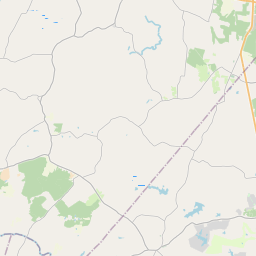York: Lewis and Clark Expedition
Historical marker location:
Ladysmith, Virginia
( Marker is on Jefferson Davis Highway (U.S. 1) 0.2 miles north of Ladysmith Road (Virginia Route 639), on the right when traveling south.)
Marker installed: 2009







© OpenStreetMap contributors
A brief timeline of the Lewis and Clark Expedition
- 1803: President Thomas Jefferson commissions Meriwether Lewis, his personal secretary, to lead an expedition to explore the western territories of the United States and find a practical route to the Pacific Ocean.
- 1804: Lewis meets up with William Clark, a former army officer and experienced explorer, in Kentucky. They assemble a team of over 30 men and set out on the journey up the Missouri River.
- 1805: The expedition reaches the Rocky Mountains and crosses the Continental Divide. They build Fort Clatsop on the Pacific coast and spend the winter there, before returning east in the spring of 1806.
- 1806: Lewis and Clark split up to explore different routes on their way back to St. Louis. They reunite in September and return to civilization, where they are celebrated as national heroes.
- 1807: The Lewis and Clark Expedition publishes an official account of their journey, called the "History of the Expedition Under the Command of Captains Lewis and Clark," which becomes a bestseller and helps to promote westward expansion.
The first slave ship to arrive in the American colonies landed in Virginia in 1619. Virginia became a center of the transatlantic slave trade, and by 1860, Virginia had the largest population of enslaved people in the United States.
About Caroline County
Caroline County Timeline
Caroline County, located in the central part of Virginia, has a rich and diverse history that dates back to its establishment in 1728. Named after Queen Caroline of England, it was originally part of Essex County until it gained its own independent status. The county was an important hub for transportation and trade, as it was crossed by several major roads and the Rappahannock River, which provided easy access to other areas of the state.
During the American Revolution, Caroline County played a significant role in the fight for independence. It was home to numerous patriots who actively participated in the war effort, including General George Weedon, who served alongside General George Washington. The county also witnessed the Battle of Mataponi Creek in 1781, where American forces successfully repelled a British raiding party.
In the 19th century, Caroline County experienced significant economic and social changes. Agriculture, particularly tobacco farming, became the backbone of the local economy, leading to the rise of large plantations and a reliance on enslaved labor. The county also became a center for trade, with numerous market towns and trading posts scattered throughout the area. However, the institution of slavery and the Civil War had a lasting impact on Caroline County, as the county faced the challenges of post-war Reconstruction and the struggle for civil rights.
In the 20th century, Caroline County underwent further changes as modernization and industrialization took hold. The construction of major highways, such as Interstate 95, transformed the county into a vital transportation corridor, connecting Washington, D.C., and Richmond. Today, Caroline County continues to embrace its history while looking towards the future, with a mix of rural charm, historic landmarks, and economic development initiatives.
During the American Revolution, Caroline County played a significant role in the fight for independence. It was home to numerous patriots who actively participated in the war effort, including General George Weedon, who served alongside General George Washington. The county also witnessed the Battle of Mataponi Creek in 1781, where American forces successfully repelled a British raiding party.
In the 19th century, Caroline County experienced significant economic and social changes. Agriculture, particularly tobacco farming, became the backbone of the local economy, leading to the rise of large plantations and a reliance on enslaved labor. The county also became a center for trade, with numerous market towns and trading posts scattered throughout the area. However, the institution of slavery and the Civil War had a lasting impact on Caroline County, as the county faced the challenges of post-war Reconstruction and the struggle for civil rights.
In the 20th century, Caroline County underwent further changes as modernization and industrialization took hold. The construction of major highways, such as Interstate 95, transformed the county into a vital transportation corridor, connecting Washington, D.C., and Richmond. Today, Caroline County continues to embrace its history while looking towards the future, with a mix of rural charm, historic landmarks, and economic development initiatives.
Caroline County Timeline
This timeline provides a concise overview of the key events in the history of Caroline County, Virginia.
- 1727 - Caroline County is formed from Essex, King and Queen, and King William counties.
- 1732 - The county seat is established in a new town called Port Royal.
- 1742 - The first courthouse is built in Port Royal.
- 1803 - Bowling Green becomes the new county seat, replacing Port Royal.
- 1861-1865 - Caroline County experiences significant impact from the American Civil War.
- 1910 - The Ashland Iron Ore Company starts mining operations in the county.
- 1939 - The U.S. Army purchases land in Caroline County to establish Fort A.P. Hill.
- 1979 - The Caroline County Historical Society is founded.